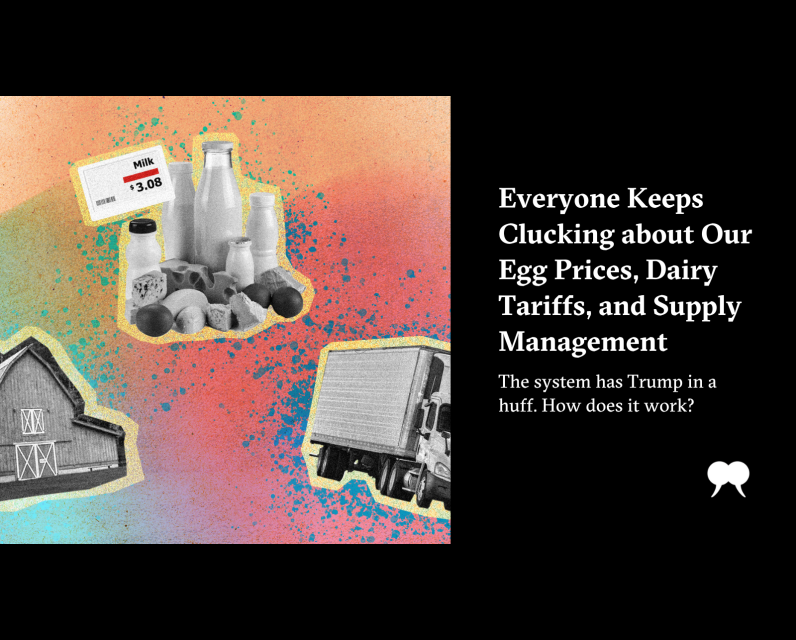Source Feed: Walrus
Author: Solarina Ho
Publication Date: July 16, 2025 - 10:02
Everyone Keeps Clucking about Our Egg Prices, Dairy Tariffs, and Supply Management
July 16, 2025

More than 168 million birds have been lost or culled since the latest strain of avian flu hit US farms in 2022. It’s a mind-boggling figure that helped send egg prices in American supermarkets to historic highs this year—so high that some people were instead decorating potatoes and marshmallows over Easter. In Canada, farmers have lost 14.4 million birds to the aggressive virus, but prices have remained more stable. At the retail level, you can still find a dozen free-run eggs on sale for $5, whether you’re in Vancouver, Toronto, or Halifax.
Canadian farmers—and Canadians in general—have been lucky, thanks in part to a supply management system for eggs, poultry, and dairy that was put in place more than half a century ago. The system has invited steady criticism over the years, with some economists and other free-market proponents arguing it is time for Canada to abolish it. Canada is the only developed economy with supply management policies, and it has become a point of contention during global trade negotiations over the past two decades.
For the most part, supply management is one of the few topics all political parties appear to agree on; it is untouchable. Prime Minister Mark Carney has said it is part of Canada’s economic sovereignty and “off the table” when it comes to negotiations with the US. Even so, there is uncertainty as to how the trade war might impact these industries. In June, a new law protecting supply management received royal assent, but experts told the CBC that the legislation might not save the system, which is seen as the “No. 1 trade irritant” by US president Donald Trump, who zeroed in on dairy when he paused trade talks with Canada in late June.
As the Trump administration upends the world order with a sweeping trade war, Canada may be edging into its own era of protectionism—a term that typically evokes disdain. But in a moment of international volatility and economic anxiety, the country’s tightly shielded system for staple industries feels more sacred than ever.
Supply management is a system built on three “pillars” or controls: production, price, and imports. Five national marketing boards, including the Egg Farmers of Canada (EFC), the Chicken Farmers of Canada (CFC), and the Canadian Dairy Commission (CDC), work with their provincial counterparts and Ottawa to administer the system. Farmers purchase quotas that regulate how much of a certain commodity they can produce and put on the market (those who don’t have quotas have limits set by each province). In return, consumers pay a guaranteed minimum price for that product.
Prices may be slightly higher compared to other jurisdictions, like the US, but should still be fair. This means the supply and demand of these food staples remain stable even in the face of disruptions and a volatile market. For the first two pillars to work, limits are set on what products can be imported.
Supply management came about when agricultural markets in the 1960s and ’70s were dealing with chaotic cycles of overproduction, shortages, and price fluctuations. It was a disorganized era marked by inequity and regional conflicts. Whatever regulatory groups existed were highly fragmented and regional, making them toothless when trading with other jurisdictions. Dairy farmers, for example, had less bargaining power than processors; they also lost a key customer when the UK joined the European Economic Community. Farmers in some sectors struggled to negotiate fair prices. They were putting in a lot of money up front, with no guarantee they could sell their product at a high enough price to make the business sustainable. It was a risky business model.
Meanwhile, Ottawa could not compete with US subsidies, and it was causing significant budgetary concerns. Under Pierre Trudeau’s government, farmers were given the chance to become supply-managed instead. When the Farm Products Marketing Agencies Act was passed in 1972, it allowed for the creation of the eggs, poultry, and dairy market boards we know today. Around that same period, US farmers went in a different direction, ramping up massive, industrial-sized, mega-factory farms to produce food more cheaply.
The Canadian system has largely held for over half a century, though new trade agreements have slowly chipped away at some of the import controls. “We live in a global market, so there’s no point in controlling production and pricing if we can just import these products for a cheaper price,” said Sarah Berger Richardson, a food law and policy expert and associate professor with the Faculty of Law at the University of Ottawa.
Dairy trade has been a sticking point: more foreign cheeses and butter varieties find their way onto Canadian grocery store shelves thanks to trade agreements like the Comprehensive Economic and Trade Agreement (CETA) with the European Union in 2017 and the Canada–United States–Mexico Agreement (CUSMA), the NAFTA-renamed deal negotiated in 2018.
But it’s not enough for Trump. He’s mischaracterizing Canada’s steep tariffs as ripping the US off and threatening to impose reciprocal ones. The enormous levies—298.5 percent on butter, for example—would be triggered only if US exports exceeded their allowed quota, which they have not. The US already exports $1.18 billion in dairy products to Canada, up from $699.5 million in 2018, making us its second-largest importer after Mexico. But US exporters say they haven’t come close to filling the allowed quota negotiated under CUSMA because of permit rules. Businesses with a permit under the tariff rate quota (TRQ) system can import products, but as it stands, only Canadian processors and distributors—who compete with American exporters—are eligible. The US dairy industry, and some Canadian retailers, want that to change.
It’s too soon to tell how the trade war will impact supply-managed sectors, experts and industry stakeholders say, but even if they are not directly impacted, farmers could still be hit through the higher costs of imported feed, equipment, and other input costs due to tariff uncertainty.
The highly pathogenic H5N1 flu outbreaks have taken a heavy toll on farmers on both sides of the border. In Canada, poultry farmers in British Columbia have been hit hardest. But evidence suggests our supply-managed system has helped shield farmers from greater losses, volatile prices, and supply shortages. From October 2024 to the first quarter of 2025, almost 70 million US hens, about 16 percent, have been culled; in Canada, roughly 1.2 million hens, or a little over 3 percent, have met the same fate, says Roger Pelissero, chair of the EFC.
“We’ve been able to help those farmers get those barns depopulated, cleaned, and repopulated with hens again to continue to produce eggs without any major disruptions,” he said. “Consumers would have noticed little, if any, disruption or shortage.”
Burnbrae Farms, the largest family-owned egg producer and processor in Canada, is headquartered in Lyn, Ontario. President and CEO Margaret Hudson says the system has proven to be very resilient during challenging times. “As an example, we are shipping eggs to BC from farms in other parts of Canada to help boost our stock while local farms get back to full production,” Hudson wrote via email.
Burnbrae, one of twenty federally registered egg processors, says it partners with 400 egg farmers across the country to grade and process roughly 35 percent of Canada’s eggs—its own farms account for 20 percent of those eggs. Overall, Canada has over 30 million hens spread across the country, with 1,200 egg farmers housing an average of 22,500 laying hens, according to the most recent annual report by the EFC.
In contrast, everything is bigger and more concentrated south of the border. The US had more than 310 million commercial laying hens at the end of 2024, according to the US Department of Agriculture, with the top ten producers home to more than 50 percent of them. The country’s largest producer, Cal-Maine Foods, based in Ridgeland, Mississippi, houses 44 million hens across its facilities—in other words, more than Canada’s entire egg-laying hen population. Many other farms can hold as many as 2 to 4 million in a single facility.
American farms have been “highly concentrated to produce these eggs in the cheapest places possible,” said Jodey Nurse, a historian, public policy researcher, and faculty lecturer with the McGill Institute for the Study of Canada at McGill University.
Canada’s collaborative system ensures a level of food security that less-regulated agricultural sectors cannot provide, advocates say, noting that having more localized farms that are spread further apart, and located across the country, make them more resilient to outside forces that can’t be controlled, such as the avian flu, sheltering farmers better from devastating losses.
Thanks to market stability, farmers can also afford to implement better animal welfare and sustainability measures that increasingly matter to consumers; it’s a work in progress, but egg farms are working toward phasing out conventional hen housing, with a number of them operating free-run and free-range farms. In addition, having more local farms supplying local markets means communities are less impacted by supply chain disruptions, like those experienced during the early pandemic years, or border and road closures due to wildfires.
“You’re building into that resilience to risk, which is increasingly significant,” said Berger Richardson, whose research focuses on the regulation of the agri-food sector.
And the challenges ahead will only grow, she added, pointing to the pandemic, bird flu, and wildfires as examples. “We’re going to see more of those.”
The egg industry generates about $300 million in tax revenues and contributes $1.3 billion to Canada’s GDP, according to Pelissero, but critics call supply-managed systems a cartel, which is defined as a group of manufacturers or suppliers who maintain high prices and restrict competition. But what sets these industries apart from a cartel, advocates argue, is the social contract that exists between consumers, farmers, and producers.
The marketing boards are run by farmers who would not be able to operate or exist without support from all levels of government, politicians, and Canadians. There have been periods where farmers have absorbed increased costs in order to keep prices stable, Nurse said, adding, “There’s that level of social responsibility that doesn’t exist at the corporate level.” The current price of eggs, for example, has been held for probably over a year already despite the avian flu outbreaks, said Pelissero.
Marketing boards have no control over retail prices, however. The system, which publishes producer prices on their websites, creates more honesty and transparency than we see in the US, said Anelyse Weiler, an assistant professor of sociology at the University of Victoria, whose area of research includes animal agriculture.
The high cost of groceries has also made supply-managed commodities a target, particularly among those who believe deregulation will lead to more competition and thus lower prices. According to Statistics Canada data compiled by Dalhousie University’s Agri-Food Analytics Lab, the average price increase since 2017 for supply-managed products such as milk, chicken, cheese, and yogurt has been below the overall 30.2 percent increase for all food categories (eggs, cream, and butter were above, though “not by a significant margin”).
Sylvain Charlebois, a professor and researcher in food distribution policy at Dalhousie and senior director of the lab, wrote in a 2024 column for Canadian Grocer that it was challenging to conclude that supply-managed products have significantly exacerbated the cost of food for Canadians, based on data over the past decade. However, in a July opinion piece for iPolitics, Charlebois called supply management outdated and argued for reform, especially in the dairy industry, pointing to inefficiency, milk dumping, palm oil additives in feed, and the need to scale up baby formula production domestically.
A major point in the debate about supply management versus free markets that often goes unaddressed is the enormous subsidies other countries provide, especially for dairy. Dairy farmers are producing so much, making the price per litre so low, that they would not be able to survive without federal and state funding, said Berger Richardson.
A 2018 report for the Dairy Farmers of Canada estimated that American dairy farmers received $22 billion a year in direct and indirect expenditures, equivalent to about 73 percent of revenues. That works out to about $174 (US) per household. Americans are arguably paying twice for their dairy products—once at the grocery store and again through taxes that help subsidize low farm income. At the same time, the average American dairy farm managed to turn a profit only twice between 2000 and 2023, according to a report by the Food & Water Watch. The paper also noted that over the past several decades, Canada lost a smaller percentage of farms compared to the US.
Seen through these lenses, it’s hard not to see the appeal. “It doesn’t cost the government, so there’s no subsidies. It’s a self-sustaining system,” said Nurse.
Supply management, though, isn’t perfect and “we shouldn’t romanticize it,” Berger Richardson acknowledged. When it comes to eggs, some argue the quota system is a cost-prohibitive barrier to entry that shuts out smaller farmers who want in. Egg farmers without a quota who exceed the number of hens allowed (300 in Alberta, for example) could face legal repercussions. And farmers want more control over when to vaccinate their hens without worrying about trade implications.
Had supply-managed Canadian farmers chosen a less regulated path, consumers could have had more variety and options. There’s a chance our markets would be flooded with cheaper eggs or milk for a time, but if more Canadian farmers went out of business, prices would likely rise alongside increased consolidation, much like in the US.
Given the system’s hallowed status, any calls for deregulation are unlikely to succeed. But even Australia dismantled supply management by 2000, following reforms that began in the 1980s aimed at gradually opening up its dairy market and making it more efficient and competitive. Having studied what happened after, however, Nurse says the change has not benefited Australian farmers. Promised export opportunities never materialized, and they are producing less than they used to and importing more. Farmers have gone out of business. And while prices initially dropped, they went up again. According to the Food & Water Watch report, Canadian dairy prices, for example, are actually lower than Australia’s.
Yes, a more open market would offer more variety, competition, and may create greater efficiencies, experts acknowledge, but it would be fragile and come at a cost to the environment and rural economies, to stability, and to taxpayers. Supply management can help avoid “a race to the bottom,” said Weiler.
Back when egg, poultry, and dairy farmers chose the supply management route, pig farmers stayed on the free-market path because the alternative would have forced farmers to reduce output. Today, the $6.5 billion industry exports 68 percent of its production to the world. As a global commodity, pork producers are forced to be more competitive. At the same time, the lack of restrictions and global reach means it can contribute more to Canada’s GDP and strengthen international relationships through trade, said René Roy, chair of the Canadian Pork Council.
That same exposure, however, means geopolitical tensions can be more detrimental for farmers than any market disturbance, Roy said, especially in recent years. When African swine fever moved from Europe to China in 2018 and decimated China’s pork industry, Quebec farmers made significant investments in order to fill the void and export to China. When China no longer wanted Canadian pork, producers were left scrambling to find new markets.
“It’s not the market that affects us the most. It is the political decisions,” said Roy, pointing to the extradition case of Huawei executive Meng Wanzhou that soured Canada’s relationship with China. “Of course, it’s never stated officially, but we know that it’s directly linked with closures of the Chinese market. . . . We hope that there will be a reset in the relationship between China and Canada.”
Today, the same thing is happening with the US trade war, he said: it’s more about politics than markets.
Food systems are clearly vulnerable to geopolitical tensions. The supply-managed stability and protections around our egg, dairy, and poultry staples make them less tied to the market swings influenced by tensions between world leaders or following political events—though some argue legislation limits Canada’s ability to negotiate in other trade deals. The current situation feels precarious, with Canada waiting to react to the whim of an unpredictable neighbour.
Now is the opportunity to rethink many aspects of trade and how we can make our supply-managed industries more robust, experts and stakeholders say. With all the uncertainties and risks at home and globally, it may be easier for Canadians to appreciate the value of the system as our food security and sovereignty feels increasingly under threat.The post Everyone Keeps Clucking about Our Egg Prices, Dairy Tariffs, and Supply Management first appeared on The Walrus.
Def Leppard sent the Ottawa Bluesfest crowd back to the 80s during the hit-packed main-stage concert that kicked off the festival’s second week with the city still under a heat warning. Read More
July 17, 2025 - 01:16 | Lynn Saxberg | Ottawa Citizen
After receiving a warm welcome and widespread support just 24 hours earlier, Alberta Premier Danielle Smith faced a more vocally critical and frustrated crowd as she and her hand-picked panel members assembled in Edmonton for the second of a series of summer town halls.“We sound like bratty children,” said Roberta Stasyk, a resident of Fort Saskatchewan, Alta., who was one of many speakers who showed up to voice their frustration.
July 17, 2025 - 00:08 | Jack Farrell | The Globe and Mail
A man who took control of one of the club's planes then flew it to Vancouver International Airport, forcing them to close their airspace, ground flights and divert nine others.
July 16, 2025 - 21:03 | Kylie Stanton | Global News - Canada



Comments
Be the first to comment